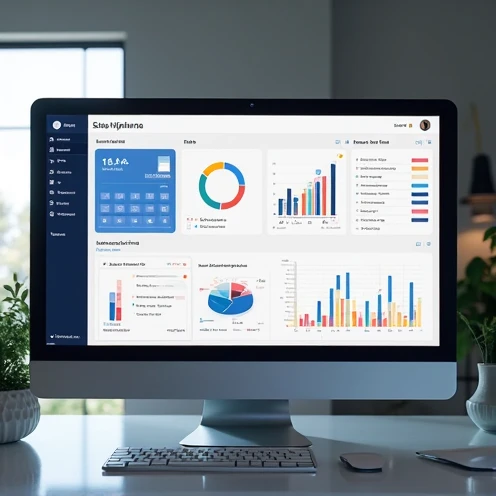How ERP And CRM Integration Transforms Modern Businesses
In the ever-evolving business landscape, companies constantly seek smarter ways to improve productivity and customer satisfaction. One of the most impactful strategies is integrating ERP and CRM systems. While these platforms serve different functions, bringing them together unlocks powerful benefits.
Iklan Google AdSense
ERP (Enterprise Resource Planning) handles internal processes like finance, inventory, and human resources. CRM (Customer Relationship Management) focuses on building and maintaining customer relationships. When integrated, they provide a unified view of operations and customers, improving overall performance.
The Core of ERP: Internal Strength and Efficiency
ERP software is the digital backbone of an organization. It connects key departments like finance, supply chain, procurement, and HR into a centralized system. This improves data accuracy and ensures all teams work from the same information.
Iklan Google AdSense
With automated workflows and real-time reporting, ERP reduces manual tasks and human error. Businesses can optimize resources, cut unnecessary costs, and meet regulatory compliance more easily. It enables a strong foundation for growth.
ERP also provides detailed analytics that help managers make informed decisions faster. Whether forecasting inventory or planning budgets, everything is aligned and accurate.
CRM Explained: The Key to Customer Success
CRM tools are designed to manage customer interactions, track leads, and boost sales. They help businesses understand their customers better and build lasting relationships. Every call, email, or purchase is recorded and accessible to sales and service teams.
This leads to personalized service, faster response times, and stronger loyalty. CRM systems also support automated marketing, helping you run campaigns that truly resonate with your audience.
With features like lead scoring and sales pipeline tracking, CRMs help teams close more deals and manage performance effectively. In the age of customer-centric business, CRM is essential.
Why ERP And CRM Are Better Together
Integrating ERP and CRM creates a single source of truth. No more jumping between platforms. Sales teams get access to inventory and shipping data. Finance gets customer payment history. Everyone sees the same real-time data.
This alignment means smoother workflows and faster service. When a sales rep sees an order delay in ERP, they can proactively inform the customer through CRM. The result? Better communication and trust.
It also eliminates redundant data entry, saving hours of work and reducing mistakes. Integration bridges the gap between front-end sales and back-end operations.
Boosting Sales with Unified Data ERP And CRM
ERP and CRM integration gives salespeople access to real-time data about product availability, pricing, and order history. This makes quoting faster and more accurate, which impresses customers and builds credibility.
Moreover, sales reps can cross-sell or upsell based on reliable purchase history. For example, if ERP data shows a product a customer frequently buys is back in stock, the CRM can trigger an automated message. That’s smart selling in action.
Enhancing the Customer Experience
Customers expect fast, personalized service. Integration helps your team meet those expectations. When CRM agents see an order status or payment issue in ERP, they can handle it immediately—no delays, no confusion.
Better still, marketing teams can design personalized offers based on ERP data, such as location, purchase frequency, or credit status. This leads to more relevant interactions and higher conversion rates.
Customers feel valued when businesses anticipate their needs, not just respond to them. Integration makes that possible.
Real-Time Insights for Smarter Decisions
Business leaders need accurate data to act quickly. With integrated ERP and CRM systems, dashboards provide a real-time view of sales, revenue, inventory, and customer satisfaction—all in one place.
This visibility allows for better forecasting, improved strategy, and faster reaction to changes in demand or supply. It also highlights operational bottlenecks or areas where customer engagement needs improvement.
With all teams accessing the same data, decision-making becomes transparent and collaborative, strengthening organizational alignment.
Cost Reduction Through Process Automation
One major benefit of ERP and CRM integration is cost efficiency. It reduces manual data entry, prevents duplicate records, and avoids miscommunication between departments.
This saves time, minimizes errors, and frees up employees for more meaningful tasks. Maintenance costs also go down because you’re managing fewer systems.
Over time, these efficiencies add up to significant savings. Plus, companies can reallocate budget toward innovation and customer engagement rather than fixing operational issues.
Greater Agility and Scalability
As your business grows, your systems must keep up. ERP and CRM platforms—especially cloud-based ones—are designed to scale. Integration ensures your processes stay efficient even as complexity increases.
Whether you open a new branch, expand product lines, or enter new markets, a unified system adapts without disrupting daily operations. You stay flexible and responsive, which is critical in fast-changing markets.
Many platforms now offer drag-and-drop integrations or plug-ins, making the process easier than ever.
Common Challenges and How to Overcome Them
Integration does present some hurdles. Data migration, staff training, and selecting the right technology stack are all potential challenges. But they are manageable with proper planning.
Start with a clear goal: better customer service, faster order processing, or streamlined communication. Then choose platforms that are built to work together or support open APIs.
Also, prepare your team with proper training and change management. Having a project champion internally can make a huge difference in adoption and success.
Choosing the Right ERP And CRM Tools
There are many software options available, from all-in-one suites to modular solutions. Microsoft Dynamics, Zoho, Salesforce, and Oracle are popular choices that support seamless integration.
Choose software based on your industry, team size, and long-term goals. Look for vendors with a track record in both ERP and CRM, plus strong customer support.
Don’t forget to prioritize security and compliance—especially if you handle sensitive customer or financial data.
The Competitive Edge of Integration
Companies that embrace ERP and CRM integration set themselves up for long-term success. With better visibility, faster workflows, and stronger customer relationships, you’re not just running a business—you’re building a smarter one.
It’s not about adding more tools. It’s about making the tools work together. The return on investment is higher satisfaction, better decisions, and sustainable growth.
If you’re serious about scaling efficiently and delighting your customers, now is the time to bring your ERP and CRM systems together.
Iklan Bersponsor Google






